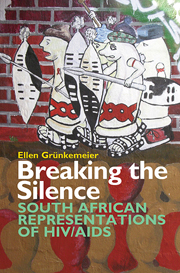3 - HIV/AIDS as a Taboo Topic: A CULTURE OF SILENCE
Published online by Cambridge University Press: 05 October 2013
Summary
Statistics
HIV/AIDS has long been a taboo topic in South Africa; however, judging by available statistics (as problematic as they might be), the scope of the South African epidemic can hardly be overestimated. According to the UNAIDS World AIDS Day Report 2011, South Africa has the highest number of people living with HIV/AIDS in the world; approximately 5.6 million South Africans are HIV-positive (UNAIDS 2011, 7). Comparing the findings of national health surveys from 2002, 2005 and 2008, it becomes evident that the overall HIV prevalence has stabilised at approximately 11% (Shisana et al. 2009, 30). Although variations between men and women are notable, particularly in younger age cohorts, women still face a higher risk of infection in almost all age groups. The results of the three surveys show persistently high levels of HIV prevalence among women, increasing rapidly with age, reaching 6.7% among 15-19-year-olds, 21.1% among 20-24-year-olds and peaking at 32.7% among 25-29-year-old women (ibid., 30-1). Young women aged 15 to 19 are about 2.5 times more likely to be infected than their male counterparts; aged 20 to 24, they are at about a four times greater risk of infection; and in the age group 25 to 29, HIV prevalence among women is about twice as high as among men. For males, by comparison, the epidemic curve peaks at 25.8% among 30-34-year olds.
- Type
- Chapter
- Information
- Breaking the SilenceSouth African Representations of HIV/AIDS, pp. 29 - 66Publisher: Boydell & BrewerPrint publication year: 2013



